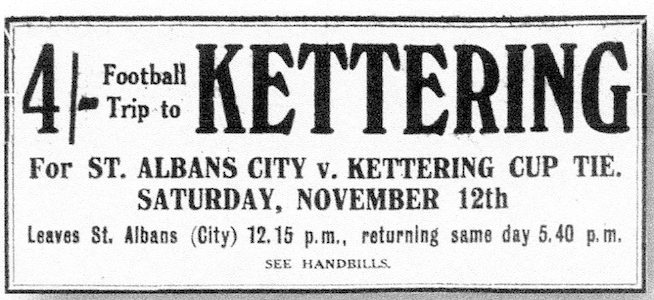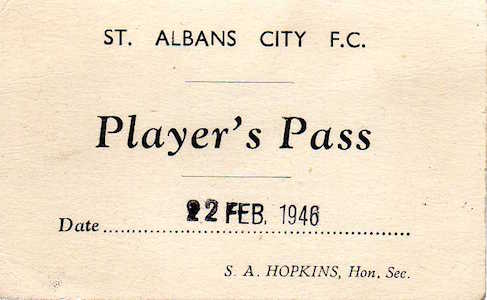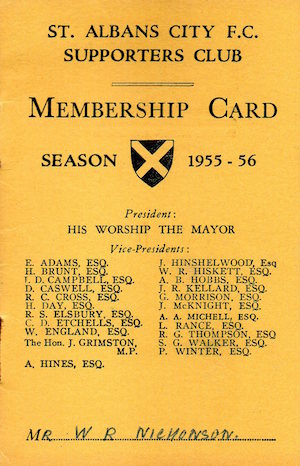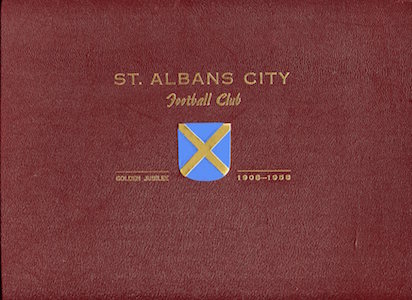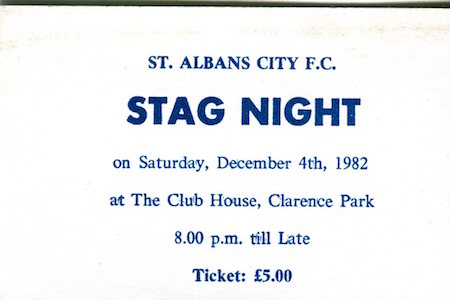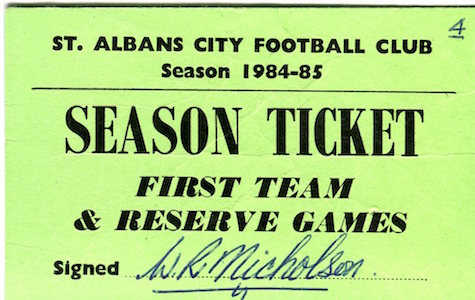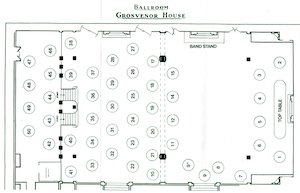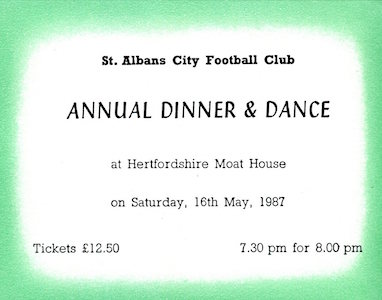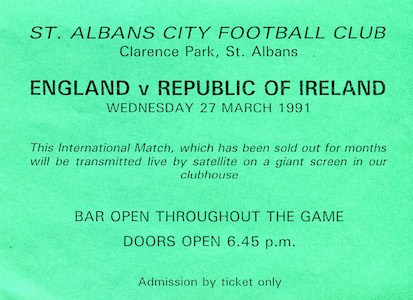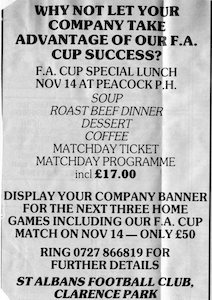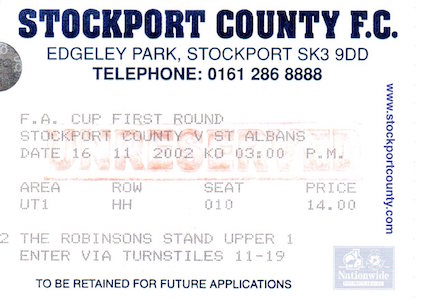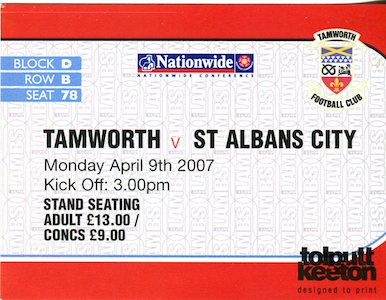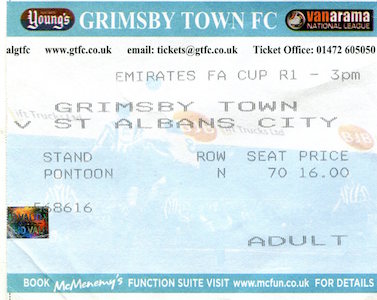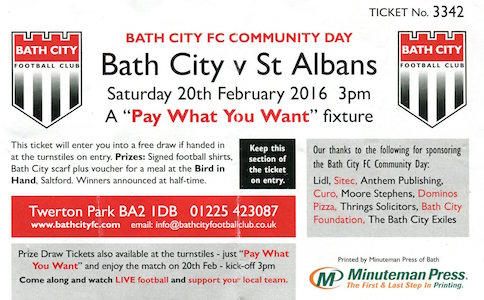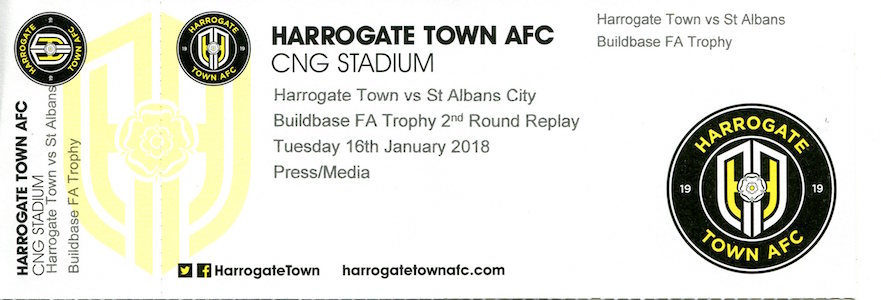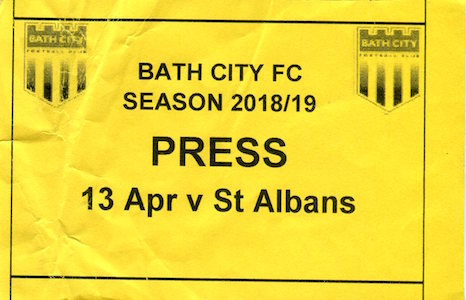To get in anywhere you need a ticket, or at least an invitation. In this section we take a look at matchday tickets and a whole lot more that is part of the rich tapestry of the history of St Albans City Football Club.
The collection includes an invitation to the opening of Clarence Park , tickets to City matches in the Amateur Cup semi-finals, itineraries for games at Highbury, Maine Road and overseas trips with the City. Before buying your ticket on the gate you need to get to the ground, so there are railway fliers to various games.
The collection also has press passes, fixture cards, tickets to club events, Supporters Club Membership cards, ambitious promotional schemes and a letter inviting a City player to attend a match in France but as nothing more than a Reserve.
The collection kicks off with the opening of Clarence Park that was to become the home of the original St Albans club and then, in 1908, St Albans City.
1894
Jack Dickerson, the goalkeeper and captain of the original St Albans club, received an invitation to attend the Opening Ceremony of Clarence Park for Monday 23rd July 1894. Jack, born in Bishop’s Stortford in 1871, was a teacher at the Hatfield Road Board School, which was attended by Wilf ‘Billy’ Minter. Dickerson later took to being a football referee and was in charge of the 1911 Amateur Cup Final between Bromley and Bishop Auckland at Herne Hill.
 Clarence Park opening invitation
Clarence Park opening invitation
1921-22
City’s Reserve team goalkeeper for the 1921-22 season was Markyate resident F.Blake. Here he is informed, by City’s Reserve team hon. secretary William Seabrook, that he has been selected to play against Bank of Scotland on 15th October 1921. The Bankers preformed under the name of Scottish Strollers and it is not difficult to understand why they played under a different name; they lost 13-1.
 1921-22 Bank of Scotland Invitation
1921-22 Bank of Scotland Invitation
1921-22
One of the greatest names to play for the club during our golden era of the 1920s was Harold Figg. Harold played in Trial Matches and was selected as a Reserve on several occasions but, sadly, never appeared for the England Amateur International team. In this letter from Frederick Wall, secretary of the Football Association, Harold is invited to travel to Paris to be a Reserve for England’s game against France on 28th February 1922.
1922-23
St Albans City made three appearances in the semi-final of the Amateur Cup during the 1920s. The first of the trio was against London Caledonians at Luton Town’s Kenilworth Road ground. The match attracted a gate of 13,950 but City were not at their best and went down to a 2-0 defeat. Four thousand City supporters made the short journey to Luton by train with an estimated one thousand getting there by other means.
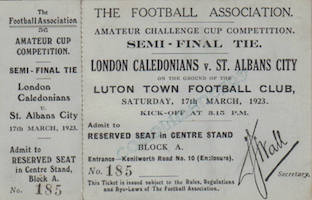 1923 St Albans City v London Caledonians
1923 St Albans City v London Caledonians
1923-24
The 1923-24 season was St Albans City’s first as members of the Isthmian League and, shortly before wrapping up the title, City had the honour of staging an England Amateur International Trial Match at Clarence Park . Included in the team for ‘The South’ was City player Ted Miller, one of a trio of Miller brothers who played for the club during the 1920s. Ted scored twice during the South’s 5-1 win. It was estimated that poor weather kept up to three thousand people away from Clarence Park that day but the game still attracted 3,427 paying spectators.
1924-25
City’s second appearance in the last four of the Amateur Cup involved another short journey, this time to Vicarage Road to tackle Southall. A crowd of 18,797 saw a goal by Redvers Miller, who played one game for Watford, earned City a replay. Unfortunately, it was just a stay of execution and our cup run ended the following Saturday at Brentford in front of 16,670 spectators.
1924-25
In March 1925 a strong Amateur XI defeated the Professionals of the South at Highbury 3-1 in a match that was to try out two alternatives to the then current offside law. The Amateur side may as well have been called England, as ten of the eleven players did play for our national side. The team included City players Wilf Minter and Fred Dear, and it was Dear who was the only uncapped player. What was gained from the experiment is open to conjecture but The Herald was pretty clear in what it thought of the lessons to be learnt; ‘There was no chance to see how the 40 yards area or the two players scheme could work, for the players made no attempt to the exploit the tactics they frequently do in competitive football, which rendered the fixture futile.’ Stanley Rous, no stranger to referring St Albans City matches, ran the line. Below is the match itinerary card, provided by the F.A., and Fred Dear’s gold winners medal (courtesy of Bryan Horsnell).
 |  |  |  | 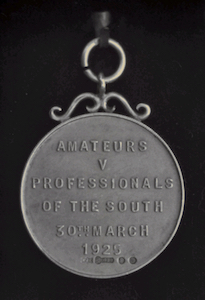 |
1925-26
Getting a ticket for a game or being selected to play is one thing, getting there is another thing altogether. In March 1926 the Football Association, quite ridiculously, decreed that the Amateur Cup semi-final between Stockton and our boys should be played at Middlesbrough’s Ayresome Park. For Stockton the journey was barely six miles, for City it was the other end of the country. City attendances at this time were phenomenal, it was not unusual for 25-30% of the population of St Albans to be attending matches at Clarence Park . For the trip to Middlesbrough, as detailed below, 215 hardy supporters splashed out 17/6 for a Third Class train ticket and a further two shillings and sixpence for each meal.
1926-27
Wilf ‘Billy’ Minter was back in the ‘Amateurs’ side for another match against the Professionals in October 1926 and enhanced his already considerable reputation with a brace of goals in the Amateurs 6-3 victory. The game was played at Maine Road, Manchester, and was for the F.A. Charity Shield. As mentioned in the itinerary card, the players had to supply their own shorts and, although not mentioned, one imagines their socks too. Somewhat disappointingly, the game drew a crowd of just 1,500 spectators.
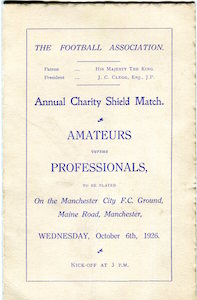 1926 Amateurs v Professionals 1926 Amateurs v Professionals |  1926 Amateurs v Professionals 1926 Amateurs v Professionals |
1926-27
At the end of the 1926-27 season St Albans City embarked on a trip to Liege in Belgium to compete for the splendid Grand Tourni de Paques. With wins over Liege Bressoux and Royal Standard Liege, City returned with the large trophy and displayed it in Green & Winter’s store in Market Place. One oddity of the competition was that a size four ball was used rather than the regular size five. City’s two matches attracted good attendances of 7,000 and 10,000. This was City’s second overseas venture with the club having won the Victory Cup in the Channel Islands twelve months earlier. As described in the letter sent out by the club, the City players had to fund their own way for the trip to Belgium. The letter seen here was sent to Harold Figg.
1927-28
After coughing up £5 10s for the Easter trip to Belgium, a more modest travelling cost of 4/- was required to see City in action at Kettering Town in the FA Cup 4th Round Qualifying the following November. If translated into goals then the 4/- train fare is a good deal at 4d per goal. The only problem is that an injury hit City side conceded nine of the ten goals scored.
1929-30
Clarence Park played host to various representative games during the 1920s ranging from inter-county matches, Amateur England trial matches and, in this example, inter-league matches. Two City players, Wilf Minter and W.C. Neil, were included in the starting XI for the Isthmian League side against Spartan League, while Harold Figg was first Reserve. The game finished all square at 2-2
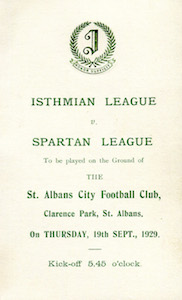 1929 Isthmian 1 1929 Isthmian 1 |  1929 Isthmian 2 1929 Isthmian 2 | 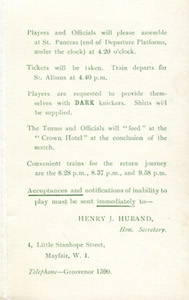 1929 Isthmian 3 1929 Isthmian 3 |
1936-37
Jumping forward seven years we are back on the trains as the London Midland and Scottish Railway provide transport for City’s FA Cup encounter with Golders Green in north London. Golders Green were previously known as Hampstead Town and, in 1946, would change their name again this time to Hendon. The St Albans contingent in a crowd of 3,814 was given as around 600 with 419 getting to Cricklewood on the Special Excursion. The cost was 9d, or 1/3d if you prefer but was of no great value from a St Albans point of view as we bowed out of the cup 4-0.
1936-37
After a successful season – 12th out of 14 in the Isthmian League and no cups in the Boardroom – City sat down for an evening of reflection and some dinner at the Peahen Hotel on 12th June 1937. The menu was signed by several of the people in attendance including Wilf Minter and Harold Figg.
 1937 Dinner 1 1937 Dinner 1 |  1937 Dinner 2 1937 Dinner 2 |  1937 Dinner 3 1937 Dinner 3 |
1937-38
Sixteen years after our previous player selection card we now have one that informed Ted Holton that he was to play at right-half for City’s match away to Leavesden on 12th March 1938. Ted had actually picked up an injury during the previous week’s Isthmian League defeat away to Nunhead and had not recovered in time for this game. The trip to Leavesden also ended in defeat and but Leavesden’s aspirations of retaining the Herts Senior Cup were dashed in the final by Hitchin Town. We have precious few of these selection cards but, somehow, have collected around six of Ted Holton’s down the years.
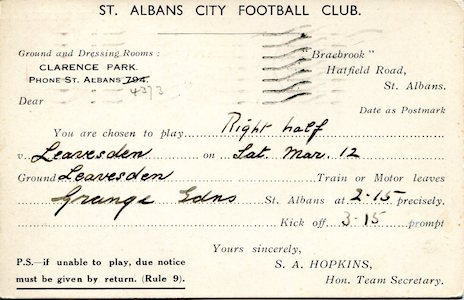 1938 Ted Holton Selection Card
1938 Ted Holton Selection Card
1937-38
We’re now back on the trains for two AFA Senior Cup ties against Lewes. Ten years on from our final Isthmian League title success, the club was struggling on the pitch and a semi-final against Sussex County League side Lewes offered the opportunity to pick up some silverware. Poor finishing by both sides led to a goalless draw at the Saffrons ground in Eastbourne before City bowed out of the competition with a single goal defeat in the replay at Gander Green Lane, Sutton. City hon. secretary Sid Hopkins had his work cut out in filling the 150 seats for the excursions to be run to both games. But, somehow, it was achieved and the special trains were run to both games.
1938-39
Although not known at the time, this was the final full season of Isthmian League football before the ghastly spectre of World War II became a reality. During the 1930’s the club had just once finished inside the top five and the 1937-38 season saw us looking up at all the other clubs at the end of the season for the first time in our history. However, we went into the new season still as members of the Isthmian League and a smartly designed fixture card was produced. In addition to the names of City officials Sid Hopkins, Jack Squire and Bill Constable, was that of the hon. team secretary Leslie Hosier. Back in November 1912 Les had become the first player to complete 100 games for the club.
 1938 39 Fixture card 1 1938 39 Fixture card 1 |  1938 39 Fixture card 2 1938 39 Fixture card 2 |
1945-46
This was City’s first season after the war and, as with the last season before hostilities began, Sid Hopkins was the hon. secretary. Here he has issued a pass for one of the visiting players for our 7-3 Herts Charity Cup 1st Round win over Welwyn Garden City at Clarence Park . The date is the 2nd of February (the 22nd was a Friday).
1946-47
The ‘you can’t come in here without a ticket’ rule applies here as the Club looks to boost sales of season tickets. Given that it was a fair bit cheaper to purchase a Ladies ticket than a Gents ticket one wonders how much cross-dressing went on back in 1946 during our first game of the season, (against Ilford on 31st August 1946, a 2-2 draw). By this time the war had been over for more than a year but still appeals for clothing vouchers were ongoing as the Club tried to kit the team out with limited resources. The notes were written by M.A.W., Bill Marriner.
1948-49
Haute Marne, a team consisting of players from two clubs, St Dizier and Chaumont, became the first French side to play at Clarence Park when popping in on Easter Monday, 18th April 1949. After the game both sets of players and various officials and dignitaries were treated to a dinner at the Town Hall. City won the game 2-0.
 1948-49 Haute Marne Menu 1 1948-49 Haute Marne Menu 1 | 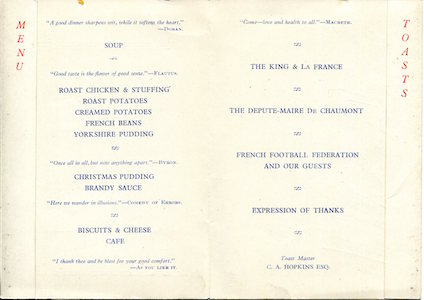 1948-49 Haute Marne Menu 2 1948-49 Haute Marne Menu 2 |
1948-49
The Waterend Barn advertised on the front cover of the matchday programme at various times between 1939-49 and they got their money back on 20th October 1948 when the Supporters Club held its Annual Dinner & Dance inside the wonderful old barn.
 1948-49 Supporters Club 1 1948-49 Supporters Club 1 | 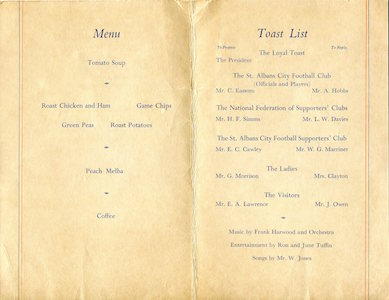 1948-49 Supporters Club 2 1948-49 Supporters Club 2 |
1949-50
Earlier in this collection we looked at fliers for railway excursions to away games, this time the football boot is on the other foot as details are laid out for Walton & Hersham supporters to get to Clarence Park . Given that the crowd for the Amateur Cup tie was given as 4,750 it would seem that a good number of visitors from Surrey took advantage of the train.
1950-51
This one certainly does not qualify under the ‘no ticket, no entry’ criteria but is a nice touch. It is a Christmas card from 1950 from France, highlighting the friendships made when Haute Marne visited St Albans in April 1949.
1950-51
We struggled to get away from the lower reaches of the Isthmian League table for many years after the war but those splashing out 15/- to attend the annual dinner and dance in Victoria Street will have had some cause for merriment. On the final day of the season we moved through to the final of the Herts Charity Cup that was held over until the next season, and one week earlier Hitchin Town were brushed aside in the final of the Herts Senior Cup. The only blemishes were indifferent league form and being beaten by Cambridge City in the semi-final of the A.F.A. Invitation Cup in between the two Herts cup games.
1952-53
Harvey Dockerill was the City hon. secretary between 1946-47 and 1958-59 and, as such, was in charge of the distribution of tickets for the visit of Oxford University on the 8th November 1952. Each visiting club was allowed a certain number of tickets to allow free admission to the officials but later this was relaxed to the visiting clubs simply forwarding by email a list of officials, media and volunteers apparently deserving of free entry to games.
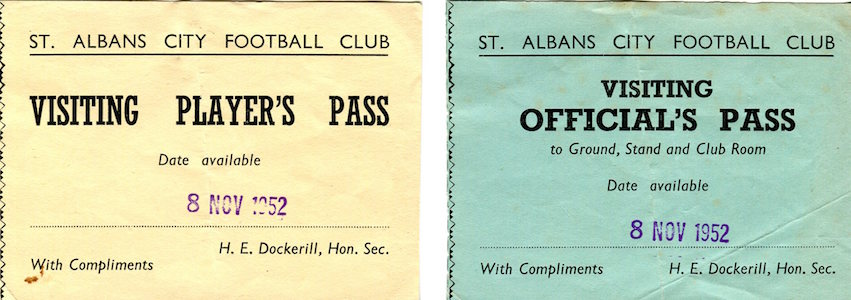 1952-53 Passes v Oxford University
1952-53 Passes v Oxford University
1955-56
Bill Nicholson, City’s hon. treasurer for more than 30 years prior to his death in 2010, worked on the Supporters Club committee before jumping up to the committee of the senior club. There are some interesting names on his Supporters Club Membership Card here, none more so than former player Archie Michell. Archie played 28 times for the Club prior to the First World War before emigrating to Canada where he became a senior figure in the Toronto police force. He remained in touch with the football club with frequently published articles in the Herts Advertiser, the matchday programme and supporters club magazines.
1956-57
For the 1956-57 season we had a Special Pass as issued by ‘Doc’ Harvey Dockerill. Not quite certain who would be the beneficiary of such a ticket but City club officials would seem a reasonable guess.
1957-58
In April 1958 the Club celebrated its 50th anniversary with a night out at the Waterend Barn. A souvenir booklet was produced complete with gold tassels and a club fob. The booklet contained a seven-page (error-riddled) account of our first 50 years. Also included was a greeting by Sir Stanley Rous, secretary to the Football Association, and also best wishes from W.R. Watson and S.A. Donaldson of the Herts F.A. and Isthmian League respectively. The signed copy shown here includes the signature of the City captain Fred Collings.
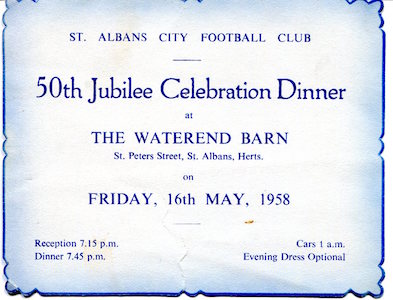 Jubilee Waterend Barn 1 Jubilee Waterend Barn 1 |  Jubilee Waterend Barn 2 Jubilee Waterend Barn 2 |  Jubilee Waterend Barn 3 Jubilee Waterend Barn 3 |  Jubilee Waterend Barn 4 Jubilee Waterend Barn 4 | 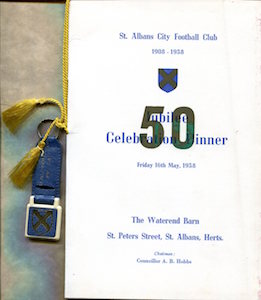 Jubilee Waterend Barn 5 Jubilee Waterend Barn 5 |
1957-58
An embossed address that was signed by 131 people present at the 50th Anniversary celebrations. Bound inside is a copy of the menu, with history and fob, three pages of press cuttings and six photographs from a friendly against German side Scheswig 06. Less interesting are almost 50 blank pages. It is 13" x 10" (33cm x 25cm) and it is believed that just one copy was produced.
1960-61
In the summer of 1960 and 1961 St Albans City visited France to compete for the Victor Linart Trophy (Victor Linart was a Belgian cyclist, 1889-1977). The itinerary card below gives the full arrangements from departing St Albans on Friday 19th May to returning the following Tuesday evening.
 1960-61 Whitsun Tour France 1 1960-61 Whitsun Tour France 1 |  1960-61 Whitsun Tour France 2 1960-61 Whitsun Tour France 2 | 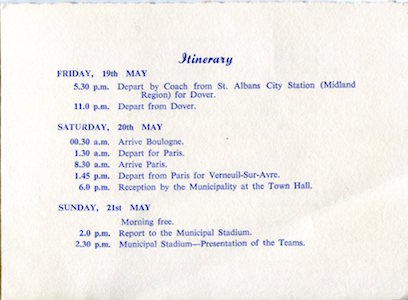 1960-61 Whitsun Tour France 3 1960-61 Whitsun Tour France 3 |  1960-61 Whitsun Tour France 4 1960-61 Whitsun Tour France 4 |
1964-65
Eastern Counties League side Stowmarket Football Club, now Stowmarket Town, welcomed St Albans City for an Amateur Cup tie on the 2nd January 1965 and, judging by the wording on this ticket, were very precise as to where each spectator in a crowd of 638 should go. City fans accounted for around 150 of the attendance at the sloping Cricket Meadow Ground.
1965-66
After heading east in the 1st Round of the Amateur Cup in 1965, City went south a year later for a first trip to Fareham Town’s Bath Lane ground. Around 100 supporters followed the team to the south coast as the travelling support made up around 100 in a gate of 806. A hastily altered ticket suggests that there were bargains to be had.
1966-67
For the semi-final of the Herts Charity Cup on 28th February 1967 we ventured across the county to Theobalds Lane and booked our place in the final courtesy of goals from John Butterfield and Barry Bentley.
1967-68
No ticket required for this game but you will have had to purchase a programme to get into Clarence Park . Clubs could not charge an admission fee for games played on a Sunday at this time, so would get around this little problem by making admission by programme only. The 2/6 (two shillings and sixpence) forked out for the programme was money well spent as Johnny Haynes and Jimmy Hill were amongst the players on show in a game refereed by Joe Kinnear.
1968-69
On 16th November 1968 we made a visit to the 1st Round of the F.A. Cup for the first time since 1926. This ticket will have secured a seat amongst a crowd of 3,505 and a view of a Bobby Childs goal that took the two sides back to Clarence Park where a Dave Neville thunderbolt put us through to the 2nd Round in front of 5,108 spectators. It remains the most recent time when the club has declared a home attendance in excess of 5,000.
1969-70
A significant game for several reasons. First and foremost because City won and went through to the semi-final of the Amateur Cup for the first time since 1926 and, secondly, because it remains as the most recent occasion when we have played in front of a five-figure crowd, 10,200 to be precise. John Oxley and John Butterfield scored the goals that put Isthmian League leaders Wycombe Wanderers out in their own back yard.
1970-71
Further back in the collection is Bill Nicholson’s Supporters Club Membership Card for 1955-56. By the time of the 50th anniversary of the formation of the St Albans City Supporters Club Bill had moved on to become hon. assistant secretary of the organisation to Cecil Cannon. The 1955 edition contained 16 pages but this had slimmed down to a folded card 15 years later.
1980-81
The hottest ticket in St Albans in 1980 was for our FA Cup 2nd Round tie at home to Division Four side Torquay United. The price of an adult ticket was £1.50 (plus an extra 50p for a seat in the stand). Over 6,000 people filed into Clarence Park to see Paul Mayles equalise to set up a midweek replay down in Devon.
 1980-81 Torquay United 1 1980-81 Torquay United 1 |  1980-81 Torquay United 2 1980-81 Torquay United 2 |
1982-83
Sometimes, you can get more than tickets to just football matches at Clarence Park .
1984-85
The City Season Ticket for the 1984-85 season was a curious one. We had just won promotion back to Division One of the Isthmian League after just one season in the bottom Division, but, due to drainage work on the pitch in the summer, our first two league home league games (Boreham Wood and Farnborough Town) were played on opposition soil. The Isthmian League did not allow the club to switch the return fixtures to Clarence Park .
1985-86
After 355 games, injury brought to an end Paul Mayles career on 1st December 1984. One year and one day later Paul donned the City kit for one last time as First Division Watford provided the opposition for his Testimonial Match. John Barnes was unable to play but turned up to wish Paul well. Admission to the clubhouse after the game, and an opportunity to meet both teams, was by ticket only.
 1985-86 Paul Mayles Testimonial
1985-86 Paul Mayles Testimonial
1985-86
To secure a second promotion within three years under manager John Mitchell , City had to win away to Lewes on the final day of the season at the wonderfully atmospheric Dripping Pan ground. Nerves were jangling. Sixteen minutes in and with City 4-0 up the nerves had stopped jangling and the party was in full swing. City finally declared at 7-1 with Steve Perrin scoring four times.
1985-86
Next up for City after winning the Isthmian League Division One title under John Mitchell was a trip to The Grosvenor House Hotel in Park Lane, London, for the League's annual Presentation Dinner and Dance. Following on from a successful season, City were well represented with the club taking three tables (nos. 43, 44 & 49).
1986-87
A ticket to the end of season Dinner & Dance at The Hertfordshire Moat House at Markyate included a dinner and dance (if so desired), speeches by various club officials and the end of season presentations. The Roy Race Goal of the Season award went to Allan Cockram and was presented in Roy Race’s absence by scriptwriter Barrie Tomlinson.
1987-88
City had a new manager for the 1987-88 season with John Lacy replacing Mitch. John took on the role in a full-time capacity along with the commercial activity of the club. One of the first eye catching tasks that the former Fulham and Tottenham Hotspur defender did was to relaunch the fixture card at the start of the season.
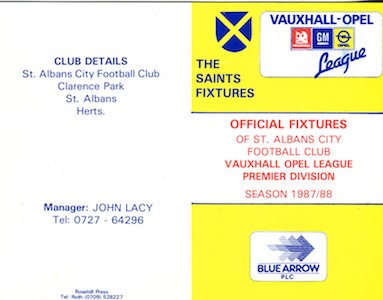 1987-88 Fixture Card 1 1987-88 Fixture Card 1 |  1987-88 Fixture Card 2 1987-88 Fixture Card 2 |
1988-89
Former City goalkeeper Doug Parkin took over the managerial hotseat for the 1988-89 season and, like his predecessor, also had control of commercial transactions at the Park. Doug oversaw the launch of the ambitious City Gold Card. As detailed in the card, it promised spectacular prizes. It was the first of three similar schemes tried by the club over the next 30 years. It was, also, the first to flop.
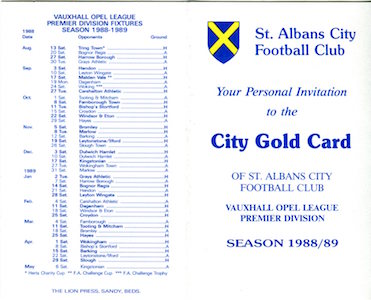 1988-89 City Gold Card 1 1988-89 City Gold Card 1 |  1988-89 City Gold Card 2 1988-89 City Gold Card 2 |
1989-90
Clarence Park has witnessed many memorable games, many mediocre games, and also its fair share of ‘why did I buy a ticket to that’ games. But on 24th September 1989 it was host to the most amazing array of talent that is likely to grace any football pitch in the world ever again. In aid of the Dreamflight charity for terminally ill children, Bobby Moore put together two teams that boasted six World Cup winners, not to mention George Best. A remarkable and certainly never to be repeated day. The V.I.P. ticket included admission to the marquee after the game where the players, all generously described as veterans by now, recuperated.
 1989-90 Panini 1 1989-90 Panini 1 |  1989-90 Panini 2 1989-90 Panini 2 |
1990-91
The issuing of complimentary tickets on matchday for opposition staff was still in operation in 1990 and were signed off by City’s hon. match secretary Syd Wells. A talented player in his day, which included playing for the revered Carlton, Syd also authorised the other passes shown here.
 1990-91 Complimentary ticket 1 1990-91 Complimentary ticket 1 |  1990-91 Complimentary ticket 2 1990-91 Complimentary ticket 2 | 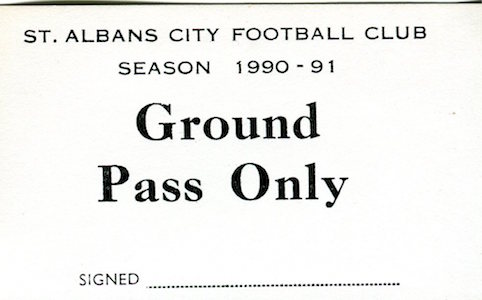 1990-91 Ground Only 1990-91 Ground Only | 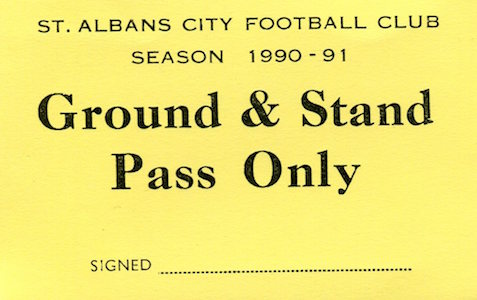 1990-91 Ground & Stand 1990-91 Ground & Stand |
1990-91
St Albans City have always struggled to take maximum advantage of the clubhouse as a seven-day-a-week source of income. But, in March 1991, efforts were made to attract people to the Park to watch, on the big screen, England’s game against the Republic of Ireland. The cost of admission to City matches this season was £3, while a ticket to watch the television at the Park for the England game was £2.50.
1991-92
The City chairman at this time was Bernard Tominey who worked for Robert Maxwell and The Mirror Group, Bernard also held a very high position within the Hilton Hotel group. Due to this it was arranged for the end of season dinner & dance to go a bit more upmarket and was held at The Hilton, Watford.
1991-92
We’re going slightly off on bit of a tangent with this one. At the end of the 1991-92 season John Mitchell , now back as manager, went with chairman Bernard Tominey, club president Ken Hill, some club officials and the players for a week in the south of France. Two games were played (a 4-1 win over Pujet and a 2-2 draw with Frejus) but in between times a train journey was made to Monaco and Monte Carlo. This is the train ticket.
1992-93
On the pitch, this was City’s most successful season for many a long day and John Colfer, a former Player of the Year, but now occasional player and full-time commercial manager, presented this attractive package ahead of the Saints 1st Round FA Cup tie with Cheltenham Town.
1993-94
Before the start of the 1993-94 season John Colfer launched a scheme every bit as ambitious as the earlier one tried by Doug Parkin . The V.I.P. Membership Card, which cost £10, offered discounts in numerous shops across the city and generous prizes in a monthly draw. Despite tremendous effort being put in by John the scheme went the same way as the City Gold Card from a few years earlier.
1994-95
The Isthmian League produced very smart credit card styled press passes for about the final ten years of our stay in that league. As can be seen from the one on the left, the league was sponsored by Diadora Sportswear for the 1994-95 season and were followed a year later by ICIS Sportswear, who folded during the 1990s.
1995-96
The cost of an adult ticket to Clarence Park remained unchanged for the third successive season at £4.50, but a visit to the clubhouse could allow the punters to walk away with a gift courtesy of Hertfordshire Police. The Boys in Blue were promoting a scheme called Operation Spider that was targeted at burglars. In connection with the football club they had printed a variety of beer mats that bore security advice. The one seen here offered advice on securing your car, it also listed City’s home matches from mid-December through to the end of April.
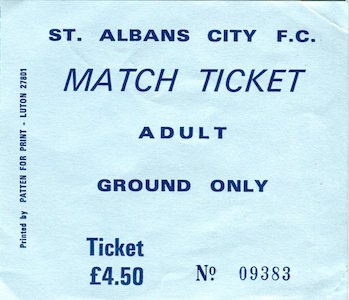 1995 96 Matchday Ticket 1995 96 Matchday Ticket | 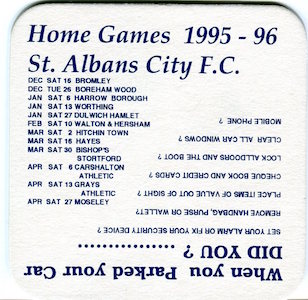 1995-96 Operation Spider 1995-96 Operation Spider |
1996-97
Some big names graced the Clarence Park turf during the 1990s as City played host to the First teams of Arsenal, Tottenham Hotspur and Coventry City. This game against Chelsea failed to live up to the other big games as Chelsea fielded a youthful side boosted by two former Arsenal veterans David Rocastle and Graham Rix. Admission to City’s home Isthmian League games rose to £5 for the 1996-97 season while a ticket to see the big guns would set you back £7.
1996-97
7th December 1996 – the day on which we shared 11 goals (not very evenly) with Bristol City at Ashton Gate. Supporters could get to the game on one of four official Supporters Club coaches or on a, cheaper, rebels coach. The price of an adult ticket at the ground was £10 with the travelling City support estimated at not far off an excellent 1,000. Steve Clark and Jon Daly scored for the Saints while Paul Agostino claimed four of Bristol City’s nine goals.
 1996-97 Bristol City 1996-97 Bristol City | 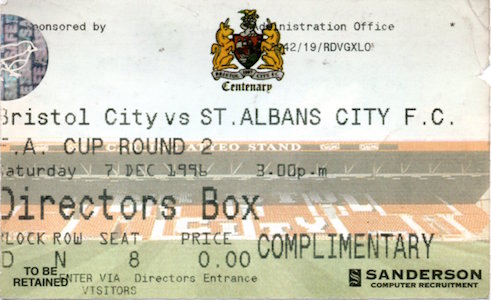 1996-97 Bristol City Ticket 1996-97 Bristol City Ticket |
1997-98
Life got a bit garish for the 1997-98 season with the Isthmian League issuing a pink press pass and Sittingbourne a dayglo ticket for visiting officials.
1998-99
Tottenham Hotspur were back at Clarence Park for a friendly in the summer of 1998 complete with David Ginola and Darren Anderton.
1998-99
City‘s FA Trophy run this season took supporters on a wonderful trip of emotions, tickets bought for any of our eight games was money well spent. Here we remember the game at Ashton United; a coach ride full of expectation through the breath-taking Pennines topped off by a Rob Haworth equaliser deep into injury time. Then, at the other end of the scale, leading 3-1 on aggregate away to Forest Green Rovers in the semi-final before succumbing to the cruellest of defeats and dreams of Wembley shattered.
 1998-99 Ashton United 1998-99 Ashton United | 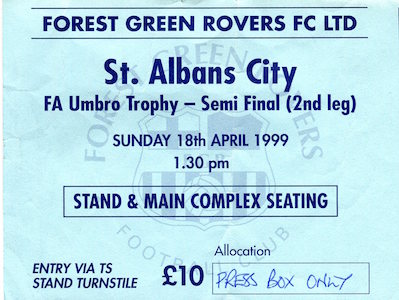 1998-99 FGR 1998-99 FGR |
1999-00
After an absence of 31 years the Herts Senior Cup made a welcome return to the Clarence Park boardroom. It was the first time that City had competed for the trophy at the now County Ground in Baldock and it was with victory over Baldock Town that Kevin Mudd’s side ended the season with some silverware.
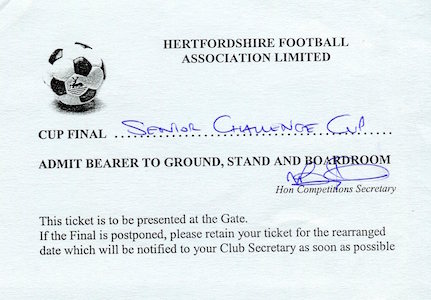 1999-00 Herts Senior Cup Final
1999-00 Herts Senior Cup Final
2000-01
Matchday admission was rising at pace at this time with the cost of an adult ticket now up to £7 for Isthmian League matches. For some unfathomable reason, the colour of the tickets was predominantly green (the colour of the Isthmian League) rather than in the club colours.
 2000-01 Tickets 2000-01 Tickets |  2000-01 Tickets 2000-01 Tickets |
2002-03
City made a return to the competition proper of the FA Cup for the first time in six years in November 2002 and for the princely sum of £14, plus a round trip of around 350 miles, supporters could see Rob Gould dismissed in a case of mistaken identity at Stockport County’s Edgeley Park home. Gould was dismissed on the word of a linesman when the culprit of an alleged handball on the goalline was Rob Kean. The City support in a crowd of 3,303 was put at around 600.
2004-05
A trip of more than 300 miles and a 3-0 defeat was not high on Steve Castle’s wish list for a Wednesday night and following a result that dumped his side at the bottom of the Isthmian League table the City boss duly resigned. Stuart Cash popped in to keep the seat warm for a week before Colin Lippiatt revived the club’s fortunes and led City to Conference South safety and promotion 18 months later. There is a bit of history behind this ticket.
2005-06
As mentioned above, Colin Lippiatt took just 18 months to turnaround our fortunes and guide the club from the Conference South into the Conference National. This ticket is from the match that ended Histon’s aspirations (but only for 12 months) and brought ours to fruition. Despite the two prices shown it is doubtful that one could haggle for a better deal. City had finished the league season 15 points clear of Histon and goals by Lee Clarke and Paul Hakim ensured that justice was carried.
2005-06
No amount of money would have persuaded the bus driver to pick up a fare as the players and officials enjoyed an open-top bus ride through the city centre to celebrate promotion. That said, there was little enjoyment for the top floor passengers as the bus moved through Clarence Park and smack into low level branches hanging over the driveway out of the park. Tickets were dished out for the reception in the Civic Centre but these were on a ‘who you know’ basis rather than for cash.
 2005-06 Bus Tour 2005-06 Bus Tour | 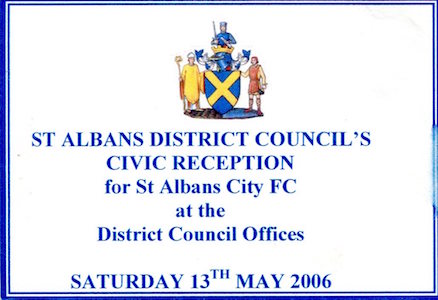 2005-06 Civic Reception 2005-06 Civic Reception |
2006-07
City were red-hot favourites for an instant return to Conference South, but life in the top flight started with a 3-1 win at Kidderminster Harriers and then, in the first home game, a goalless draw with Cambridge United. An excellent crowd of 1,912 attended that first home match but by the time that our relegation had been confirmed the average gate at the Park had slimmed down to 1,146. The purchase of a terrace ticket went up to £12 from the previous season’s £9, while a seat in the stand was an additional £2.
2006-07
The match that confirmed that we would not be hanging around for a second season in the Conference National took place at The Lamb on Easter Monday. A 1-1 draw sealed our fate but the 45 City supporters paying £13 each in a crowd of 966 had their thoughts taken off that outcome by the performance of referee Shaun Proctor-Green. He flashed his yellow and red cards a mere 11 times; and that does not include Lippiatt being removed from the dugout. This ticket is worthy of a place in the archives as, in addition to seeing Ram Marwa sent off, we also had a club record eight players booked.
2007-08
This ticket is almost a throwback to the days when the major London clubs sent strong line-ups to Clarence Park during the 1990s. Kettering Town included Christian Karembeu, Gianluca Festa, Gianfranco Zola and Les Ferdinand in a semi-final win over Rothwell Town, but the latter pair were absent when City upset the party to bring home the A-Line trophy in Richie Hanlon’s first outing as manager.
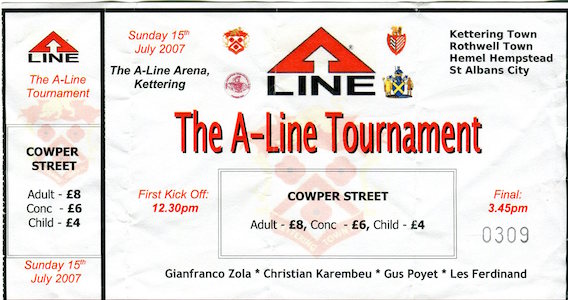 Kettering Town A Line Tournament
Kettering Town A Line Tournament
2008-09
City joined in more celebrations on the final day of the 2008-09 season but this time it was as on-lookers when forming a guard of honour for Conference South champions AFC Wimbledon at Kingsmeadow.
 2008-09 Wimbledon 2008-09 Wimbledon |  2008-09 Wimbledon 2008-09 Wimbledon |
2010-11
Back in 1894 the original St Albans club and Luton Town met in the FA Cup, 116 years later and the City club met Luton Town for the first time in a competitive fixture, again in the FA Cup. The cost of a train ticket for Luton supporters coming to St Albans in 1894 was 1s, it was probably a bit more for the return journey in 2010. Luton won the first game 6-1 and the second 4-0. The margin is closing.
2011-12
The 2011-12 season was another with a connection to the original St Albans club, as, following relegation from Conference South, St Albans City were placed in the Southern League. The original club played in that league for two years from 1897-99. Our first opponents in 2011 were Cirencester Town and a flying start was made with a 4-1 win for David Howell’s team. Here is the season ticket wallet and the first season ticket from that season.
 2011-12 Cirencester Town 2011-12 Cirencester Town | 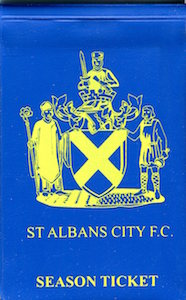 2011-12 Season Ticket Holder 2011-12 Season Ticket Holder |
2013-14
Getting a ticket to this game would be small fry compared to the cost of making the longest journey ever made by the club within the confines of England’s borders – depending on one’s route it is about five miles further than the trip to Barrow-in-Furness. The money and time spent proved to be good value as Jimmy Gray and Graham Golds’ side ran out 7-3 winners at Treyew Road. The season ended with promotion back to National League South.
2014-15
The purchase of a ticket was required for the launch of the Snowball Lottery, seen as a replacement for the defunct 100 Club. Membership was £10 per month and the prize fund was dependant upon the number of members participating.
2015-16
FA Cup glory was in the offing as City headed to Blundell Park for a 1st Round tie. In addition to the long journey, City supporters were faced with paying a higher admission price than for any other match in our history…only for it to soon be surpassed at Clarence Park . For the record, we failed to increase our number of away wins in the FA Cup Proper to two.
2015-16
Another piece of history with this ticket that marked the end of the road for Jimmy Gray and Graham Golds, as City, just three weeks after the 5-1 defeat at Grimsby, bowed out of the FA Trophy with a 4-0 drubbing away to struggling Isthmian League side Lowestoft Town.
2015-16
After the expense of long-distance failures earlier in the season, City supporters could rebalance the books a little bit with Bath City making the meeting at Twerton Park a ‘pay what you want’ fixture. Given City’s abysmal record at Twerton Park, five previous visits and yet to score a goal, a payment of close on nothing would seem quite reasonable. Whatever each individual supporter paid, the outcome was inevitable; a 1-0 defeat.
2016-17
The £15 admission fee was the same as for City’s league games that season but this game, whatever the price, was worth the cost. Two quite spectacular goals by Junior Morias and a similar effort from Louie Theophanous almost caused an FA Cup upset for Ian Allinson’s side but the locals in a crowd of 3,473 went home happy, despite Carlisle United moving through to the 2nd Round with a thrilling 5-3 victory.
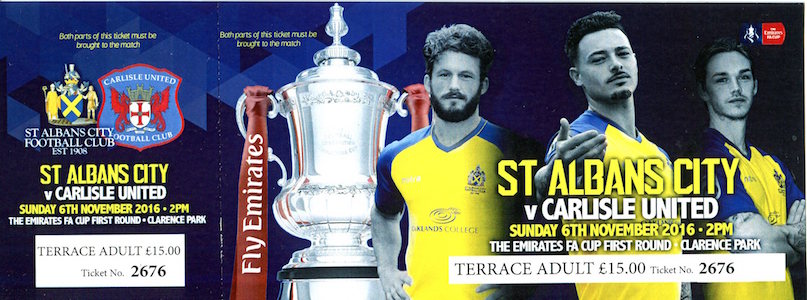 2016-17 Carlisle United ticket 2016-17 Carlisle United ticket |  2016-17 Carlisle United Boardroom pass 2016-17 Carlisle United Boardroom pass |
2017-18
Harrogate Town equalised six seconds from full time at Clarence Park , something that led to considerable expense for the City supporters that travelled to Wetherby Road on a bitterly cold, snowy, Tuesday night in mid-January for an FA Trophy 2nd Round replay. This defeat, on plastic and again by five goals, probably did not quite represent good value.
2018-19
Another historic day as City celebrated the 111th anniversary of the formation of the club with something even more remarkable; victory at Twerton Park. The previous season had seen City score their first goal in this corner of Somerset but this time Ian Allinson could do what no previous manager of St Albans City had had the pleasure of doing, and that is to talk about collecting all three points from the wonderful old ground. It was certainly value for money for those that made the trip from St Albans but the scoreline completely distorted the afternoon’s events, for Bath dominated throughout while we scored from our only on-target efforts of the afternoon.
2019-20
There was plenty of gnashing of teeth during the season as the club announced that the cost of admission to Clarence Park would be £18 for adults, by far the highest in National League South. Just to compound a tough time for the Club, the season was brought to an end two days after a 1-0 win at Braintree Town on 14th March that lifted City out of the relegation places. We still had seven games to play while Tonbridge Angels, one of the two sides that we climbed above with the win at Braintree, still had 11 fixtures outstanding. Coronavirus Covid-19 had won. Football and, tragically, many people, had lost.






